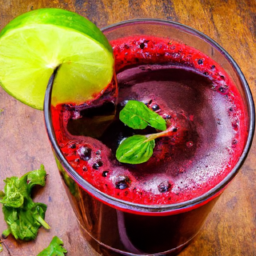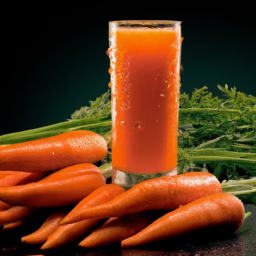Did you know that drinking beet juice could improve your athletic performance? According to a study in the Journal of Applied Physiology, consuming beetroot juice may increase your endurance during physical activity.
However, not everyone is a fan of the earthy and sometimes bitter taste of beets. If you struggle to gulp down beet juice, don’t worry – there are several ways to make it more palatable.
In this article, I will share some tips on how to make beet juice taste good. By combining the right flavors and ingredients, you can transform beet juice into a delicious and nutritious beverage that you’ll actually enjoy drinking.
Whether you’re looking to boost your athletic performance or simply add some variety to your daily routine, these tips will help you make the most of this superfood.
Key Takeaways
- Adding complementary fruits and vegetables can balance the earthy taste of beet juice.
- Enhancing the flavor of beet juice can be done by using coconut water or milk, plant-based milks, nut butters, superfoods, and natural sweeteners.
- Ingredients such as coconut water, plant-based milks, nut butters, superfoods, honey, and maple syrup offer additional benefits to the drink.
- General tips for making beet juice taste good include washing, peeling, and chopping produce before juicing, straining juice for a smoother consistency, using fresh and high-quality produce, and experimenting with different spice combinations and proportions.
Understand the Flavor Profile of Beets
Understanding the flavor profile of beets is crucial in elevating the taste of beet juice. Beets have a unique earthy flavor that may take some getting used to, but it all depends on individual taste preferences. Some people may find it too overpowering, while others may enjoy it.
Flavor balancing is key to making beet juice palatable. One way to do this is by adding other fruits and vegetables with complementary flavors. This not only balances the earthiness of beets but also provides additional nutrients. By incorporating other ingredients, you can create a delicious and nutritious juice that is enjoyable to drink.
Balance the Flavor with Other Fruits and Vegetables
I’ve found that balancing the flavor of beet juice with other fruits and vegetables is essential to making it more palatable.
Apples, for example, add a sweet and slightly tart flavor that complements the earthiness of beets.
Carrots also work well, providing a subtle sweetness and a slightly earthy taste that complements the beets.
Finally, adding a small amount of ginger can add a spicy kick to the juice, helping to balance out the sweetness and earthiness of the other ingredients.
Apples
To make your beet juice taste good, you can add some sweetness by throwing in a quarter of an apple! Apple varieties like Fuji, Honeycrisp, and Gala work particularly well, but any type of apple will do. Juicing techniques can also affect the flavor of the apple in your juice. If you prefer a more subtle apple flavor, juice the apple with the skin on. If you want a stronger apple taste, peel the apple before juicing it.
Adding apples to your beet juice not only enhances the taste but also adds a nutritional boost. Apples are a good source of fiber, vitamin C, and antioxidants. Remember, though, that apples are high in sugar, so use them sparingly. Too much sugar can offset the health benefits of your beet juice. Now, let’s move on to the next subtopic: carrots.
Carrots
Adding carrots to your juicing recipe can provide a natural sweetness and a boost of vitamin A for a healthier and tastier juice. Carrots are known for their high levels of beta-carotene, which can help improve eyesight and promote healthy skin. When combined with beets, the resulting juice can also help lower blood pressure and improve cardiovascular health.
To get the most out of your carrot and beet juice, it’s important to use the right juicing techniques. Start by washing and peeling your carrots and beets, and then chop them into smaller pieces for easier juicing. You can also try alternating between juicing the carrots and beets to create a more even mixture. For a smoother consistency, strain the juice through a fine mesh sieve or cheesecloth.
Now that we’ve covered the benefits of adding carrots to your beet juice, let’s discuss how ginger can add an extra kick of flavor and health benefits.
Ginger
If you want to add an extra kick of flavor and health benefits to your juice, try using ginger – it’s a great way to add some spice to your life!
Ginger has been used for centuries for its medicinal properties and can help reduce inflammation, improve digestion, and boost the immune system. When added to beet juice, ginger can also enhance the taste and make it more palatable.
To prepare ginger for beet juice, start by washing and peeling a small piece of ginger. Then, grate it with a fine grater or chop it into small pieces. Add the ginger to your beet juice and blend well. You can adjust the amount of ginger according to your taste preference. Don’t be afraid to experiment with different amounts to find the perfect balance of flavor and health benefits.
As you continue to experiment with spices and herbs, you’ll discover new ways to make beet juice taste delicious and reap the health benefits.
Experiment with Spices and Herbs
I’ve found that experimenting with spices and herbs is a great way to add depth and complexity to my beet juice.
Cinnamon, for example, adds a warm, sweet note that complements the earthiness of the beets.
Mint, on the other hand, provides a refreshing, cooling sensation that balances out the intensity of the beet flavor.
Turmeric is another great option, as it not only adds a subtle spiciness but also brings a host of health benefits to the table.
Cinnamon
Sprinkle some cinnamon on top of your beet juice to add a warm and spicy flavor that complements the earthy taste of the beets. Not only does cinnamon taste great, but it also has many health benefits. Cinnamon can help regulate blood sugar levels and has anti-inflammatory properties.
Additionally, cinnamon has a high antioxidant content, which can help protect against cell damage and reduce the risk of chronic diseases. When using cinnamon in your beet juice, you can experiment with different variations such as ground cinnamon or cinnamon sticks.
You can also add a touch of nutmeg or ginger to enhance the flavor profile even further. In summary, cinnamon is a delicious and healthy addition to your beet juice and can be customized to your taste preferences.
Next, let’s explore the benefits of adding mint to your beet juice.
Mint
You’ll love the refreshing burst of flavor that mint adds to your beet juice, making it the perfect drink for a hot summer day. Mint not only enhances the taste of your juice but also provides numerous health benefits.
Here are some of the benefits of mint in beet juice:
- Aids digestion: Mint is known to have a soothing effect on the digestive system. Adding mint to your beet juice can help relieve bloating, gas, and other digestive issues.
- Boosts energy: Mint is a natural stimulant that can help improve your energy levels. Drinking beet juice with mint can give you a natural energy boost without the crash that comes with caffeine.
If you’re looking for some delicious beet juice recipes with mint, here are a couple of options:
- Minty Beet Juice: Blend together 2 beets, 1 apple, 1 cucumber, a handful of mint leaves, and a squeeze of lemon juice. This refreshing drink is perfect for a hot summer day.
- Spicy Mint Beet Juice: Blend together 2 beets, 1 carrot, 1 celery stalk, a handful of mint leaves, and a pinch of cayenne pepper. This spicy drink is great for those who like a little kick in their juice.
Next, let’s move on to the benefits of adding turmeric to your beet juice.
Turmeric
When you add turmeric to your beet juice, the vibrant yellow color will remind you of a beautiful sunrise on a summer morning. But the benefits of turmeric don’t stop at its stunning appearance. Using turmeric for added health benefits in beet juice is a great way to enhance your daily nutrition.
Turmeric contains curcumin, a powerful anti-inflammatory compound that can help reduce inflammation throughout the body. Additionally, turmeric has been shown to improve brain function, support heart health, and even have anti-cancer properties.
To create unique flavor combinations with turmeric and other spices, consider adding ginger or cinnamon to your beet juice. Ginger has its own anti-inflammatory benefits and can add a spicy kick to your juice. Cinnamon, on the other hand, is a sweet and warm spice that pairs well with the earthy flavor of beets. Experiment with different spice combinations until you find your perfect blend.
Now, let’s add a touch of citrus to really take your beet juice to the next level.
Add a Touch of Citrus
For a refreshing twist, try squeezing a little lemon or lime into your beet juice. The citrus pairings add a tangy flavor that complements the earthy taste of the beets perfectly. Citrus fruits, such as lemons and limes, are an excellent source of vitamin C and antioxidants, which can help boost your immune system and protect your cells from damage.
Adding citrus to beet juice can also help neutralize the bitterness of the beets and make it more palatable. To enjoy your beet juice with a touch of citrus, here are some tips:
- Squeeze half a lemon or lime into your beet juice and stir well to combine.
- Add a slice of lemon or lime to your glass for an extra burst of flavor.
- Experiment with different citrus fruits, such as grapefruit or orange, to find your perfect combination.
Now that you know the benefits of adding citrus to beet juice, let’s explore another way to make your beet juice taste even better – by using coconut water or milk!
Use Coconut Water or Milk
Coconut water or milk can add a creamy texture and tropical flavor to your beet juice, making it a delicious and nutritious drink. Coconut water is an excellent source of hydration, as it’s rich in electrolytes, vitamins, and minerals. It also contains antioxidants that can help reduce inflammation in the body. Additionally, coconut water is low in calories and sugar, making it an ideal choice for those looking to maintain a healthy lifestyle.
If you prefer a creamier texture, you can use plant-based milk options like coconut milk, almond milk, or cashew milk. These milks are lactose-free and have a subtle nutty flavor that can complement the earthy taste of beets. They’re also packed with nutrients such as calcium, vitamin D, and healthy fats that can boost your energy levels and support bone health.
So, whether you choose coconut water or milk, your beet juice will be transformed into a delicious and nutritious drink that you can enjoy anytime, anywhere.
For an extra boost of protein and flavor, try adding nut butters to your beet juice. They can add a rich, nutty taste and a smooth texture to your drink, making it more satisfying and filling. Plus, nut butters are a great source of healthy fats, fiber, and protein, which can help keep your blood sugar levels stable and your energy levels high.
So, experiment with different nut butter combinations and find the one that works best for you.
Try Nut Butters
Adding a dollop of nut butter to your beet drink can turn it into a creamy, nutty treat that will leave you feeling satisfied and energized. Not only does it add a delicious flavor, but it also provides healthy fats and protein to your drink. There are many different nut butter pairings to try with your beet juice, and even some nut butter alternatives for those with dietary restrictions.
Here is a table with some ideas for nut butter pairings to try with your beet juice:
| Nut Butter | Pairing |
|---|---|
| Almond Butter | Beets, Carrots, Apples |
| Cashew Butter | Beets, Pineapple, Mango |
| Peanut Butter | Beets, Banana, Chocolate |
| Sunflower Seed Butter | Beets, Berries, Cinnamon |
For those with allergies or dietary restrictions, there are also nut butter alternatives to try. Sunflower seed butter, tahini (made from sesame seeds), and pumpkin seed butter are all great options. By incorporating nut butter into your beet juice, you can create a delicious and nutritious drink that will keep you energized and satisfied throughout the day.
Incorporating superfoods into your beet juice is another great way to boost its flavor and nutritional value.
Incorporate Superfoods
I hope you’ve found my previous suggestion of trying nut butters helpful in making your beet juice more palatable. Another great way to enhance the taste of your beet juice is by incorporating superfoods.
Superfoods are nutrient-dense foods that provide a host of health benefits. Adding superfoods to your beet juice not only enhances its flavor but also boosts its nutritional value. There are many superfoods that can be added to beet juice, such as chia seeds, flaxseeds, spirulina, and kale.
These superfoods are rich in vitamins, minerals, antioxidants, and fiber, which can help improve digestion, boost immunity, and reduce inflammation. The best time to consume beet juice with superfoods is in the morning on an empty stomach, as this allows for optimal absorption of nutrients. So, next time you make beet juice, try adding a tablespoon of chia seeds or spirulina powder for an added nutritional boost.
Now that we’ve covered the benefits of incorporating superfoods in a beet juice, let’s move on to the next section about sweetening with natural sweeteners.
Sweeten with Natural Sweeteners
You can easily elevate the flavor of your beet juice by using natural sweeteners like honey, agave, or maple syrup. These sweeteners provide a touch of sweetness without sacrificing the nutritional value of the juice.
Honey, for example, contains antioxidants and has anti-inflammatory properties, while maple syrup is rich in minerals like zinc and manganese. Agave syrup, on the other hand, is a low-glycemic sweetener that doesn’t spike blood sugar levels.
It’s important to note that different sweeteners can impact the taste of beet juice differently. For instance, honey has a distinct floral taste that can complement the earthy flavor of beets, while maple syrup adds a rich, smoky sweetness. Agave syrup, on the other hand, has a neutral taste that allows the beet flavor to shine through.
Experiment with different sweeteners to find the one that best suits your taste buds. And don’t forget to blend with ice or frozen fruit for a refreshing twist on this healthy drink.
Blend with Ice or Frozen Fruit
Sweetening beet juice with natural sweeteners is a healthy option, but sometimes it’s not enough to make it taste good. That’s where blending with ice or frozen fruit comes in. Not only does it add sweetness, but it also gives the juice a refreshing and smooth texture.
One way to create a delicious beet juice smoothie is to blend it with frozen berries, such as strawberries or blueberries. This will not only add a natural sweetness, but it will also give the juice a beautiful pink color.
Another option is to add frozen bananas, which will give the smoothie a creamy texture and a sweet taste. Finally, for a tropical twist, try blending the beet juice with frozen pineapple or mango. The possibilities for smoothie variations are endless, and the creative presentation can make drinking beet juice a fun and enjoyable experience.
As you experiment with different proportions and combinations of ingredients, you’ll find the perfect blend that suits your taste. But before moving on to the next section, it’s important to note that the quality of the ingredients used can greatly affect the taste of the juice. Therefore, it’s important to use fresh and high-quality produce to achieve the best results.
Experiment with Different Proportions and Combinations of Ingredients
By experimenting with various proportions and combinations of ingredients, you can discover a smoothie recipe that perfectly suits your unique taste buds and satisfies your desire for a healthy, refreshing beverage. When it comes to making beet juice taste good, it’s important to find the right balance of flavors and textures. You can achieve this by using a variety of fruits, vegetables, and other ingredients that complement the earthy, slightly sweet taste of beets.
One way to experiment with different proportions is to create a simple table that compares the ingredients and juice consistency of various recipes. For example, you could list the ingredients for three different smoothies and note whether they produce a thick, creamy consistency or a thinner, more juice-like consistency. You could also include information on serving sizes, as this can affect the overall taste and enjoyment of the beverage. By taking a systematic approach to recipe development, you can create a delicious, nutritious smoothie that incorporates the health benefits of beets without sacrificing taste.
Frequently Asked Questions
Can beet juice be stored in the fridge for later use?
Yes, beet juice can be stored in the fridge for later use. To preserve its flavor, store it in an airtight container and consume it within 3-4 days. Shake well before drinking.
What are some common mistakes people make when attempting to make beet juice taste better?
As a beet juice enthusiast, I’ve learned common mistakes when adding flavors. Too much citrus can overpower the earthy taste, and too much ginger can be too spicy. I recommend adding apple or pineapple for balance.
How long does it typically take to see health benefits from drinking beet juice?
It typically takes a few weeks to see health benefits from drinking beet juice, with optimal consumption time being in the morning on an empty stomach. Benefits duration can vary based on individual factors such as diet and exercise.
Are there any specific dietary restrictions or allergies to consider when making beet juice?
When making beet juice, it’s important to consider vegan options and any allergies. However, it’s worth it for the nutritional benefits. A plant-based metaphor is like a garden, where different ingredients can come together in harmony.
Can beet juice be used as a replacement for other beverages in a daily diet?
Yes, beet juice can be a healthy replacement for other beverages in a daily diet. Beet juice benefits include improved cardiovascular health and increased exercise performance. Recommended daily intake is 8 ounces. Compared to other vegetable juices, beet juice is equally beneficial.
Conclusion
In conclusion, making beet juice taste good isn’t as complicated as it sounds. With a little experimentation and creativity, you can create a delicious and nutritious drink that you’ll look forward to drinking every day.
By understanding the flavor profile of beets and balancing it with other fruits and vegetables, you can create a well-rounded taste that satisfies your palate. Adding spices and herbs, a touch of citrus, or incorporating superfoods can elevate the taste and nutritional value of your juice.
Sweetening with natural sweeteners or blending with ice or frozen fruits can also enhance the experience. So, don’t be afraid to experiment with different proportions and combinations of ingredients to find what works best for you.
As the famous chef Julia Child once said, "The only real stumbling block is fear of failure. In cooking, you’ve got to have a what-the-hell attitude."So, embrace the challenge and let your creativity run wild. Who knows, you might just come up with a winning recipe that will make you a beet juice lover for life.
Ilana has been a vegan for over 10 years. She originally made the switch for health reasons, but soon found herself becoming more and more passionate about the ethical and environmental implications of a vegan lifestyle. Ilana is the author of The Graceful Kitchen, a blog all about veganism. She loves to cook up delicious and nutritious vegan meals, and share her recipes with others who are interested in leading a cruelty-free life. Ilana is also a strong advocate for using whole foods as the foundation of a healthy diet, and believes that going vegan is one of the best ways to achieve this.










